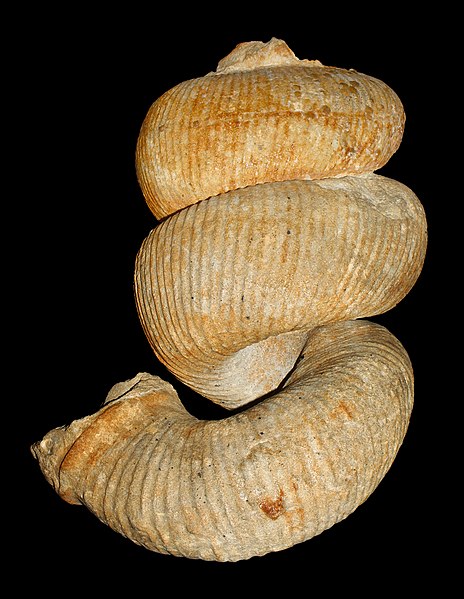[Recent Entries][Archive][Friends][User Info]
Below are the 20 most recent journal entries recorded in the "Сообщество, посвящённое ра" journal:| May 12th, 2013 | |
|---|---|
| 04:44 pm [industrialterro] [Link] |
Tusoteuthis Tusoteuthis is a genus of Cretaceous cephalopod molluscs. One species, T. longa, has been identified so far, and examination of gladius remains has yielded an estimated mantle length close to or equal to that of the modern giant squid. Recent studies suggest a closer relationship to the vampire squid than the modern day giant squid. Tusoteuthis is assumed to have preyed on other cephalopods, fish, and possibly even small marine reptiles. Despite its size, which was around 20 to 35 feet (6 to 11 meters) long with tentacles fully outstretched, Tusoteuthis was still preyed on by other animals, especially the many, various predatory fish of the Western Interior Seaway. A fossil of the predatory salmonid, Cimolichthys nepaholica, was found with the gladius of T. longa in its gullet. The back portion of the gladius was in the stomach region, while the mouth of C. nepaholica had remained opened, suggesting that the fish had died in the middle of swallowing the squid, tail first. Researchers strongly suspect that as the fish was swallowing Tusoteuthis, the head and/or tentacles remained outside the mouth, thus blocking the gills of the fish, and suffocating it as it swallowed its prey.
Репродукции (1, 2, 3, 4, 5, 6):
Ископаемые останки (1, 2, 3, 4, 5, 6):
Tags: Вымершие беспозвоночные, Мел |
| 04:27 pm [industrialterro] [Link] |
Keuppia Keuppia is an extinct genus of octopus. It consists of two species, Keuppia hyperbolaris and Keuppia levante, both of which lived approximately 95 million years ago. Both species were found in fossilized form, which is very uncommon for extinct octopuses, as the soft tissue of dead octopuses almost always disintegrates before it has a chance to fossilize. These fossils, along with those of the genus Styletoctopus, were found from the Cretaceous-age Hâqel and Hâdjoula localities in Lebanon. The presence of a gladius vestige in this genus shows a transition from squid to octopus in which the inner shell has divided in two in early forms to eventually be reduced to lateralized stylets, as can be seen in Styletoctopus.
Tags: Вымершие беспозвоночные, Мел |
| 03:23 pm [industrialterro] [Link] |
Tropaeum Tropaeum ("Trophy") is an extinct genus of ammonite cephalopod found throughout the oceans of the world during the Early Cretaceous. As with many other members of the family Ancyloceratidae, there was a trend among species within this genus to uncoil somewhat, in a very similar manner in the genus Lytoceras. The largest species, T. imperator of Australia, had a shell a little over one meter in diameter.
Tags: Аммониты, Вымершие беспозвоночные, Мел |
| May 5th, 2013 | |
| 09:20 pm [industrialterro] [Link] |
Shastoceras Shastoceras is an extinct ammonite cephalopod found in Lower Aptian sediments in Northern California. Although sometimes placed in the Heteroceratidae, a family characterized by a helically wound early portion, its form indicates it more likely belongs to the Ancyloceratidae. Shastoceras resembles Uhligia from the Lower Barremian of Germany, except for being stouter. In both genera the initial portion is short and in general straight, followed by a more or less 180 deg. bend and a straight to moderatley curved shaft ending in a hook. The shaft of Shastoceras is shorter and broader than that of Uhligia.
Tags: Аммониты, Вымершие беспозвоночные, Мел |
| 08:43 pm [industrialterro] [Link] |
Scaphites Scaphites (Greek skafh, "a boat or anything dug or scooped out") is a genus of extinct cephalopod belonging to the family of heteromorph ammonites (suborder Ancyloceratina). They were a widespread genus that thrived during the Cretaceous period. Scaphites generally have a chambered, boat-shaped shell. The initial part (juvenile stage) of the shell is generally more or less involute (tightly-coiled) and compressed, giving no hint of the heteromorphic shell form yet to come. The terminal part (adult stage) is much shorter, erect, and bends over the older shell like a hook. They have transverse, branching ribs with tubercles (small bumps) along the venter. Reconstructions of the body within the shell can be made to portray Scaphites as either a benthic (bottom-dwelling) or planktonic animal, depending on where the center of gravity is located. Since useful fossils of the soft-body parts of cephalopods are highly rare, little is known about how this animal actually fit into its shell and lived its life. Because Scaphites and its relatives in Superfamily Scaphitaceae are restricted to certain divisions of the Cretaceous (ca. 144 to 66.4 million years ago), they are useful in some areas as an index fossil. A notable example is the Late Cretaceous Western Interior Seaway in North America, in which several endemic lineages of scaphite species evolved and now serve as the basis for a highly resolved regional biostratigraphy.
Ископаемые останки (1, 2, 3, 4):
Tags: Аммониты, Вымершие беспозвоночные, Мел |
| April 20th, 2013 | |
| 09:03 pm [industrialterro] [Link] |
Pravitoceras Pravitoceras is an extinct genus of ammonite. Nostoceratidae is a diverse family of heteromorph ammonites found throughout the oceans of the world during the Late Cretaceous. The nostoceratids are famous for the bizarre coiling of their shells. Many genera, such as Yezoceras, Ainoceras, Anaklinoceras, and some species of Bostrychoceras and Eubostrychoceras, display, as young shells at least, a helical coiling very similar to the shells of the related family, Turrilitidae. As adults, though, the coils then curve away from the axis of coiling, either as an oxbow-like curve around the juvenile coils as in Ainoceras and Anaklinoceras, or in a simple curved loop beneath the juvenile coils, as in Yezoceras. Other genera form loose coils, sometimes in a spiral, such as those of Madagacarites, Muramotoceras, Hyphantoceras, and the infamous Nipponites. The ecology of nostoceratids is the subject of continued speculation, as the bizarrely coiled shells have no streamlining, strongly suggesting that the living animals had extraordinarily poor swimming ability, if any ability at all. As such, experts and ammonite enthusiasts presume that the nostoceratids either floated passively in the water column, or were bottom-dwellers that may or may not have crawled on the seafloor. The nostoceratids, as with all other Cretaceous ammonites, perished during the Cretaceous–Paleogene extinction event.
Tags: Аммониты, Вымершие беспозвоночные, Мел |
| 08:49 pm [industrialterro] [Link] |
Placenticeras Placenticeras is an ammonite genus from the Late Cretaceous. Its fossils have been found in Asia, Europe, North and South America. Placenticeras, named by Meek, 1870, is the type genus for the Placenticeratidae, a family that is part of the Hoplitaceae, a superfamily of the Ammonitida. yup. Placenticeras has a very involute shell with slightly convex sides and a very narrow venter. Side are smooth or with faint sinuous ribs. Early whorls have umbilical tubercles that in later whorls appear higher on the sides. Earlier whorls normally have lower and fine upper ventrolateral clavi. Ornament weakens in the adult and the last whorl may be smooth. The suture is with numerous adventitious and autxiliary elements, with saddles and lobes that are much frilled.
Ископаемые останки (1, 2, 3, 4):
Tags: Аммониты, Вымершие беспозвоночные, Мел |
| 08:08 pm [industrialterro] [Link] |
Phylloceras Phylloceras is an extinct genus of ammonite. Phylloceratidae is the predominant family of the Phylloceratina with some 15 or more genera found in rocks ranging from the Lower Jurassic to the Upper Cretaceous. Members of the Phylloceratidae are characterized by smooth, involute shells with very thin walls. Many are covered with fine growth lines but are usually without ribbing. Sutures are complex with the major and minor branches of the saddles with phylloid or spatulate endings. The Phylloceratidae are probably derived from the Late Triassic Discophyllitidae by increasing the sutural complexity and evolving involute coiling. The Discophyllitidae in tern have their origin in the Ussuritidae, also known as the Monophyllitidae. The Phylloceratidae gave rise at or near the beginning of the Jurassic to the ancestral Lytoceratina, the early Lower Jurassic Peluroacanthitidae and Ectocentridae. The Phyloceratidae also gave rise at or near the beginning of the Jurassic to the Psilocerataceae which unites families of the Early Jurassic Ammonitina. Other Jurassic Ammonitina are derived from the Lytoceratina. Later, phylloceratids are said to have given rise to Cretaceous Ammonitina included in the Desmocerataceae, Hoplitaceae, and Acanthocerataceae. Sutures in the Phylloceratidae vary in complexity and are usually described on the basis of the saddles, which diverge to the front. Saddle endings may be double (diphyllic), triple (triphyllic), or quadruple (tetraphillic). Branching may be asymmetric. Intervening lobes are variably branched with thorn-like or spinose terminations as viewed in plan.
Ископаемые останки (1, 2, 3, 4):
Tags: Аммониты, Вымершие беспозвоночные, Мел |
| April 17th, 2013 | |
| 08:31 pm [industrialterro] [Link] |
Parapuzosia Parapuzosia is an extinct genus of desmoceratid ammonites from the Cenomanian to the Campanian of Africa, Europe, and North America. They are typically very large ammonites, reaching diameters of 60 cm (2.0 ft) or more. It possess a moderately involute shell with flat or slightly rounded sides. Distinct primary and secondary ribbing can be observed in the inner whorls. Parapuzosia seppenradensis is the largest known species of ammonite. It lived during the Late Cretaceous period. A specimen found in Germany in 1895 measures 1.8 m (5.9 ft) in diameter, although the living chamber is incomplete. It is estimated that if complete, this specimen would have had a diameter of approximately 2.55 m (8.4 ft) or even 3.5 m (11 ft). The total live mass has been estimated at 1,455 kg (3,210 lb), of which the shell would constitute 705 kg (1,550 lb). Parapuzosia bradyi is a gigantic species of ammonite, reaching diameters of more than 4.5 ft (1.4 m) by 6 ft (1.8 m). It is the largest species of ammonite in North America. It had a moderately involute shell with flat sides. The inner whorls are slightly oval-shaped with prominent ribbing. They are only known from the upper layers of the Eagle Sandstone and Cody Shale formations (both Late Cretaceous).
Размеры тела в сравнении с человеком:
Ископаемые останки (1, 2, 3, 4):
Tags: Аммониты, Вымершие беспозвоночные, Мел |
| 07:12 pm [industrialterro] [Link] |
Pachydiscus Pachydiscus is an extinct ammonite genus from the Upper Cretaceous with a world-wide distribution, and type for the desmoceratacean family Pachydiscidae. Its type is P. neubergicus. Altogether some 28 species have been described. The shell of Pachydiscus is compressed and high-whorled, with an oval or flat sided section. Ribs tend to be differentiated into short umbilical and separate ventro-lateral sets, with a smooth area between. Pachydiscus includes two subgenera, P.(Pachysiscus) from the Campanian in which the ribs persist, and P (Neodesmoceras) from the Maastrichtian in which ribs disappear early, leaving an almost smooth shell.
Ископаемые останки (1, 2, 3, 4):
Tags: Аммониты, Вымершие беспозвоночные, Мел |
| 06:44 pm [industrialterro] [Link] |
Nostoceras Nostoceras is an extinct genus of ammonite from the Campanian stage of the Upper Cretaceous, found in the USA, England, central Europe, west Africa, and Madagascar. The etymology of the name Nostoceras comes from "nostos" meaning return and "ceros" meaning horn, named as such by Alpheus Hyatt because it bends back on itself. Nostoceras is typified by a tightly coiled helical spire on a large U shaped body chamber with the aperture, in mature individuals, nearly touching and lying underneath the spire. The initial helical whorls are covered with fine ribs and may have small spines. The U shaped body chamber has coarser ribbing and large tubercles. Periodic constrictions may be present on the phragmocone. Species may coil either to the left or to the right. Nostoceras is like Bostrychoceras in general form, except that its ribs may be flaired and the constrictions may or may not be present. Nostoceras is the type genus for the ammonite family Nostoceratidae which is included in the Turrilitoidea. The Turrilitoidea, with Nostoceras and the Nostoceratidae, are commonly included in the suborder Ancyloceratina but may instead belong in the Turrilitina, a proposed order of heteromorphs thought to have a separate derivation, though this separation does not have wide support.
Ископаемые останки (1, 2, 3, 4):
Tags: Аммониты, Вымершие беспозвоночные, Мел |
| February 27th, 2013 | |
| 07:33 pm [industrialterro] [Link] |
Nipponites Nipponites ("stone of Nippon") is an extinct genus of heteromorph ammonites. The species of Nipponites (primarily N. mirabilis) are famous for the way their shells form "ox-bow" bends, resulting in some of the most bizarre shapes ever seen among ammonites. The ecology of Nipponites, as with many other nostoceratids, is subject to much speculation.
Ископаемые останки (1, 2, 3, 4):
Tags: Аммониты, Вымершие беспозвоночные, Мел |
| 07:21 pm [industrialterro] [Link] |
Mortoniceras Mortoniceras is an ammonoid genus belonging to the superfamily Acanthocerataceae, named by Meek in 1876, based on Ammonites vespertinu, named by Morton in 1834. Mortoniceras is the type genus of the Mortoniceratinae, one of 4 subfamilies in the Brancoceratidae which is part of the Acanthocerataceae (renamed Acanthoceratoidea to conform with the ICZN ruling on superfamily endings) Mortoniceras is found in middle and upper Albian sediments, at the end of the Lower Cretaceous in Africa, Europe, North America, and South America.
Ископаемые останки (1, 2, 3, 4):
Tags: Аммониты, Вымершие беспозвоночные, Мел |
| 07:00 pm [industrialterro] [Link] |
Heteroceras Heteroceras is a Lower Cretaceous heteromorph ammonite belonging to the ancyloceratacian family, Heteroceratidae, characterized by a helically coiled juvenile shell at the apex followed by slightly curved adult shaft, with a J-shaped section at the end of it. The shell is ribbed; ribs are concave and oblique on the helix, straight and transverse on the later stages. Heteroceras has been found in France, central Europe, the Caucasus, and Peru. Related genera are Hemibaculites and Cochidites. The family, Heteroceratidae, is a derivative of the Ancyloceratidae.
Ископаемые останки (1, 2, 3, 4):
Tags: Аммониты, Вымершие беспозвоночные, Мел |
| 06:41 pm [industrialterro] [Link] |
Hamites Hamites ("hook-like") is a genus of heteromorph ammonite that evolved late in the Aptian stage of the Early Cretaceous and lasted into the Cenomanian stage of the Late Cretaceous. The genus is almost certainly paraphyletic but remains in wide use as a "catch all" for heteromorph ammonites of the superfamily Turrilitaceae that do not neatly fit into the more derived groupings. In an attempt to identify clades within the genus, it has been divided up into a series of new genera or subgenera by different palaeontologists, including Eohamites, Hamitella, Helicohamites, Lytohamites, Planohamites, Psilohamites, and Sziveshamites. The type species is Hamites attenuatus from the early Albian, named by James Sowerby in his Mineral Conchology of Great Britain of 1814, although the genus itself was created by James Parkinson in his 1811 book Organic Remains of the Former World. James Parkinson is best known as a man who made the first scientific description of a disease he called the Shaking Palsy, now referred to as Parkinson's disease in his honour. Hamites species are characterised by a shell that began with an open, sometimes helical, regular spiral that either opened into a single large hook, or else formed three parallel shafts that gave the mature shell the approximate appearance of a paper clip. No Hamites had spines or other such ornamentation on the shell, but several species appear to have developed apertural modifications when mature; that is, once the ammonite had grown to its final size, the aperture became constricted and was bounded by one or two thickened ribs, known as collars. These have been observed on other ammonites as well, and are assumed to be signs of sexual dimorphism. The open shell of these ammonites would have made them poor swimmers because of drag, but beyond that fact, very little is certain about their mode of life. It is widely assumed that they were planktonic, perhaps catching small prey in the manner of jellyfish, but repaired shell damage apparently caused by crabs may indicate that they spent at least some time close to the sea floor. The genus Hamites is of particular interest to palaeontologists because the species included in the genus span a wide range of morphologies including ones apparently similar to several more derived groups of heteromorph ammonites. The genus rapidly diversified during the Albian into a number of morphologically distinct lineages that seem to have given rise to at least three other families of heteromorphs, the Baculitidae, Turrilitidae, and Scaphitidae. The lineage that gave rise to the helical Turrilitidae, for example, had a shell that initially grew as a helix before straightening out; the Turrilitidae thus appear to have been derived from neotenic Hamites that retained the helically-coiled juvenile morphology of Hamites into adulthood.
Tags: Аммониты, Вымершие беспозвоночные, Мел |
| 06:33 pm [industrialterro] [Link] |
Exiteloceras Exiteloceras is an ammonite genus from the Late Cretaceous. Its fossils have been found in Egypt, Iraq, and North America. Exiteloceras was proposed by Alpheus Hyatt in 1894 for heteromorph ammonites with shells that are loosely coiled in a plane, early whorls varying from straight limbs connected by semicircular elbows to elliptical or nearly circular loops. Later whorls being elliptical to circular. Whorl section is ovate with the dorsum on the inside curve broader than the venter on the outside. Ribs may be straight or flexuous and mostly slant. Most end with a tubule on the ventrolateral shoulder. The suture is ammonitic. The deeply incised sutural elements are asymmetric, including the double pronged ventral lobe.
Tags: Аммониты, Вымершие беспозвоночные, Мел |
| 06:02 pm [industrialterro] [Link] |
Didymoceras Didymoceras is an extinct genus of ammonite cephalopod. It is one of the most bizarrely shaped genera, with a shell that spirals upwards into a loose, hooked tip. It is thought to have drifted in the water vertically, moving up and down. The generic name is Latin for "paired horns". Its taxonomic place is often in flux, being placed in either Turrilitidae, Nostoceratidae, or its own family, Didymoceratidae. Didymoceras nebrascense was an extinct species of heteromorph ammonite from the upper Campanian age (around 83 to 70 million years ago). It was sexually dimorphic, with two adult sizes averaging at 270 mm (11 in) and 180 mm (7.1 in) high for females and males respectively. It exhibited three distinct growth stages. The first growth stage was composed of one or two straight sharply bending sections and a gently curved third. The second growth stage is composed of around three and a half loosely coiling whorls. The last (adult) growth stage is composed of a U-shaped bend facing upwards. Didymoceras nebrascense is relatively easily identifiable. It has three growth stages. The initial growth stage produces two more or less straight sections connected with each other by a sharply bent elbow. The sections are parallel to each other or diverging at an angle of 10° to 30°. The second, larger straight section is elliptical in cross-section, higher than it is wide. It connects to a third more broadly curving elbow. Like the second straight section, its cross section is also elliptical. Occasionally, some individuals only has one straight section and one curved section for the first growth stage. The middle growth stage begins at the end of the last curved limb of the first growth stage. It is composed of three and a half loosely coiled whorls. The whorls are usually widely separated, but some individuals display whorls that are just barely touching each other. The ribbing becomes denser than in the first growth stage and its cross-section is more or less circular. The third growth stage is that of the adult. It is composed of a single distinctive upward-facing U-shaped whorl. Ornamentation of Didymoceras nebrascense consists of a double row of nodes running along the ventral side. They are usually evenly matched with each other, but can sometimes alternate briefly. The straight sections of the first growth stage shows evidence of small sharp spines on the tubercles. The coiling can be to the left or right. Didymoceras nebrascense is sexually dimorphic, with adults showing two average heights - the smaller male adults (microconchs) had an average height of 180 mm (7.1 in); while the larger female adults (macroconchs) had the average height of 270 mm (11 in). Didymoceras nebrascense occurs in the western edge of the what was once an ancient sea that stretched from northern New Mexico to northeastern Montana in the upper Campanian age (around 83 to 70 million years ago) of the late Cretaceous. A putative specimen from the Mishash Formation of Israel has also been recorded in 1969. Didymoceras - еще один род семейства Nostoceratidae, достойный отдельного упоминания. В чем-то он похож на Nostoceras, но отличается большим размером, поскольку витки спирали не соприкасаются между собой. При этом они несут два ряда бугорков, пересекающих всю раковину или только жилую камеру. Самые молодые части раковины могут быть очень прямыми. Форма закручивания зависит от вида. У одних видов раковина закручивается направо, у других — налево. Виды этого рода часто встречаются в отложениях мела Европы и Америки. Одним из самых распространенных видов, представленных в Северной Америке, является Didymoceras nebracense, несущий два ряда выраженных бугорков и очень четкие ребра. Первые описания рода основывались на неполных образцах, что привело к ошибкам в классификации. В результате, часть ученых приписали его к другим родам, наподобие Cirrioceras, другие включили его в подрод Nostoceras.
Ископаемые останки (1, 2, 3, 4):
Tags: Аммониты, Вымершие беспозвоночные, Мел |
| 05:48 pm [industrialterro] [Link] |
Crioceratites Crioceratites is an ammonite genus from the Early Cretaceous belonging to the Ancylocerataceae. Crioceritites is coiled in an open, normally equiangular spiral with an oval or subquadrate whorl section. The surface is banded by fine, dense, rounded ribbing sectioned by periodically spaced thick and often spinose ribs. Crioceratites was formerly included in the Ancyloceratidae, in the subfamily Crioceratinae which was subsequently elevated in rank to the family Crioceratidae. Crioceras and Toxoceras d'Orbigny and possibly Emericiceras Sarka 1954 are junior synonyms Crioceratities fossils have been found in Lower Cretaceous Hauterevian-Barremanian, sediments in Europe, Africa, Asia, North America and South America.
Ископаемые останки (1, 2, 3, 4, 5, 6):
Tags: Аммониты, Вымершие беспозвоночные, Мел |
| 05:24 pm [industrialterro] [Link] |
Collignoniceras Collignociceras is an evolute, strongly ribbed and tuberculate ammonite from the Upper Cretaceous of the western United States and Europe belonging to the Ammonitida family Collignoniceratidae. The type is Collignoniceras woollgari, named by Mantell in 1822 for specimens from Sussex, England. Wright in the 1957 Treatise on Invertebrate Paleontology, Page L426 gave the following description for Collignoniceras. Compressed in early stages, with rounded or high and clavate siphonal tubercles tending to form serrate keel; with straight or slightly sinuous ribs and weak umbilical and strong ventrolateral tubercles; later whorls tend to be squarer in section with exaggerated ventrolateral tubercles which may absort even the umbilile tubercle. Two subspecies are known from the Turonian of western North America, C. woollgari wooolgari and C. woollgari regulari. C. w. woollgari has been found with Mammites depressus at the top of the lower shale tongue and lowermost overlying Tres Hermanos sandstone member of the Mancos Shale in New Mexico, in a shale bed at the top of the Greenhorn Formation in Colorado, and alone in sandstone and shale in the upper Frontier Formation in Wyoming. The slightly younger C. w. regulari is known from the lower Carlile Shale, which overlies the Greenhorn. It has been found in U. S. western interior from as far west as northern Arizona and eastern Utah and from New Mexico to Montana.
Ископаемые останки (1, 2, 3, 4):
Tags: Аммониты, Вымершие беспозвоночные, Мел |
| February 26th, 2013 | |
| 08:29 pm [industrialterro] [Link] |
Bostrychoceras Bostrychoceras is a genus of heteromorph ammonite from the family Nostoceratidae. Fossils have been found in Late Cretaceous sediments in Europe and North America. The shell of Bostrychoceras begins as a tightly wound helical spire, like that of Nostoceras, from which hangs a U or J shaped body chamber, at least in the adult. The shell is covered with dense, strong, but un-flaired, ribs that are commonly sinuous and oblique. May or may not have strong constrictions. Bostrychoceras были одними из первых окаменелостей, найденных в отложениях верхнего мела. Особенно часто они обнаруживаются в отложениях этого периода в Дакоте и Вайоминге, Северная Америка. Внешний вид этих ископаемых головоногих поистине удивителен. Bostrychoceras, безусловно, представляют большой интерес для коллекционеров окаменелостей. Род Bostrychoceras, очень широко представленный в верхнем мелу, входит в семейство Nostoceratidae, относящееся, в свою очередь, к надсемейству Turrilitaceae. Последнее включает в себя большое число семейств и практически все известные типы гетероморфных раковин и узоров, начиная с абсолютно гладких и заканчивая испещренными ребрами и бугорками. Несмотря на существенные различия в форме, все роды этого семейства обладают общими характеристиками, вследствие чего подразделение на подсемейства не является необходимым. Раковина Bostrychoceras может быть достаточно крупной и достигать 30 сантиметров в высоту. Для нее характерно винтообразное строение, нарушаемое на начальных стадиях роста, а у некоторых видов и на протяжении всей жизни. Витки могут закручиваться как слева направо, так и наоборот, и меняются от особи к особи. На некоторых этапах развития раковины демонстрируют тенденцию к двусторонней симметрии, наблюдаемую у других головоногих с раковиной плоскоспирального развития. Витки раковины обычно расположены под достаточно острым углом. Винтовое развитие, как правило, обрывается на жилой камере, имеющей U-образную форму и встречающейся в окаменелом виде крайне редко. Ее узор образован большим количеством выраженных ребер, проходящих по каждому витку, имеющих синусообразную или наклонную форму и способных раздваиваться. Бугорки видны довольно отчетливо, но часто бывают спрятаны под плотными ребрами. Сужения присутствуют не у всех родов. Соотношение между формой ребер и бугорков имеет большое значение для видовой идентификации. Не менее важна для таксономической классификации и лопастная линия, относящаяся у этого рода к литоцератидовому типу. Широкое географическое распространение вида Bostrychoceras polypocum позволило использовать его для датировки верхней части кампанского яруса по всему миру
Ископаемые останки (1, 2, 3, 4):
Tags: Аммониты, Вымершие беспозвоночные, Мел |

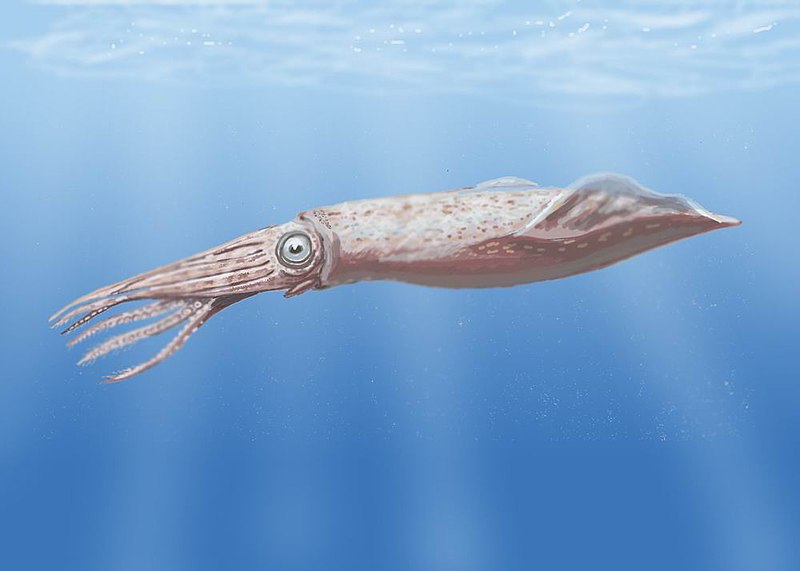


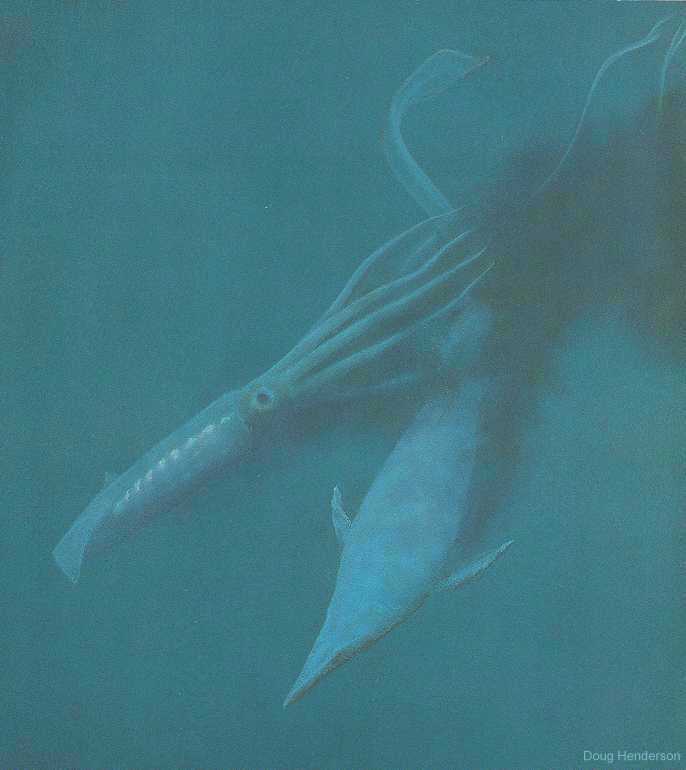








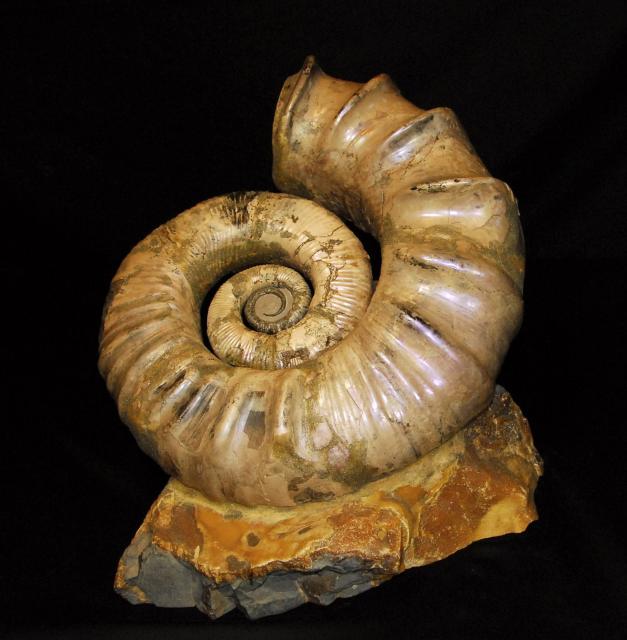







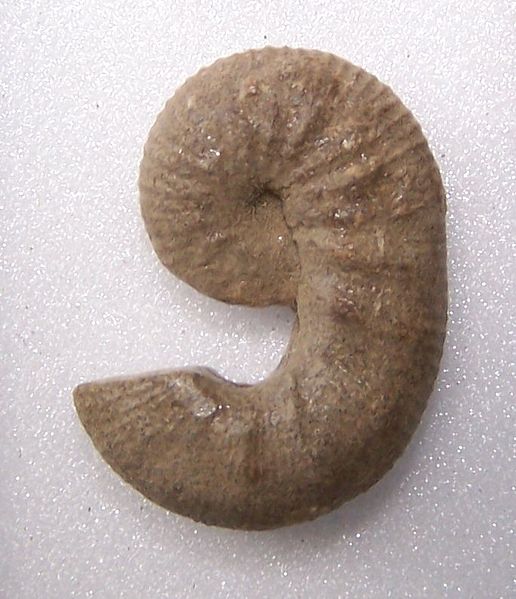



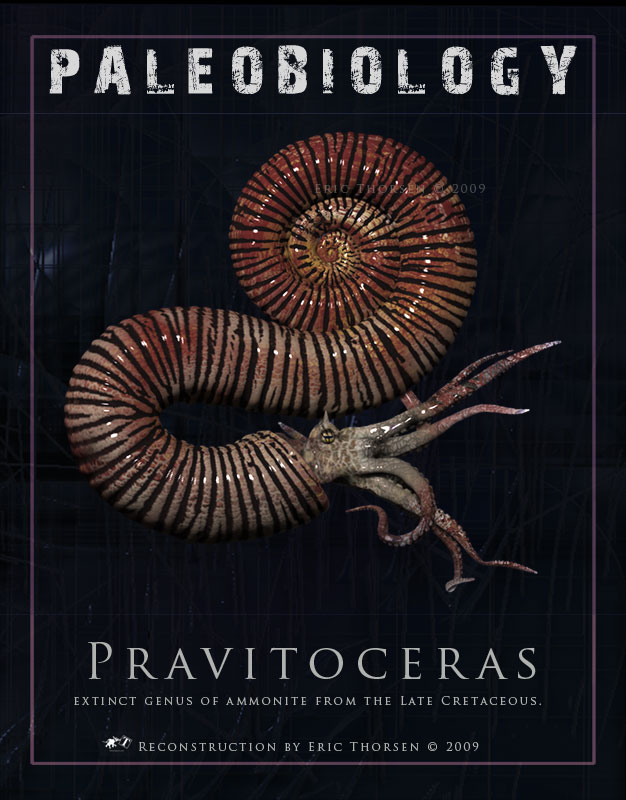













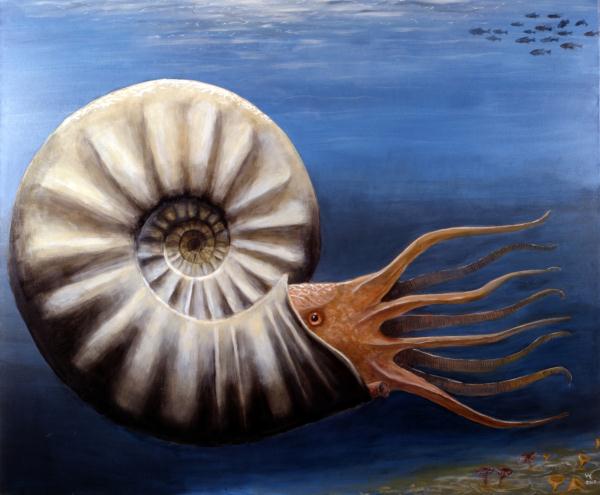

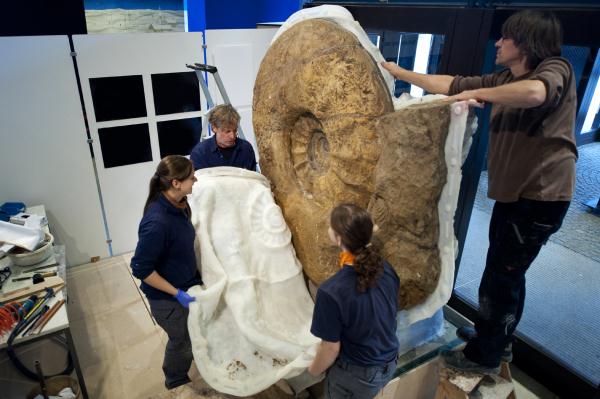













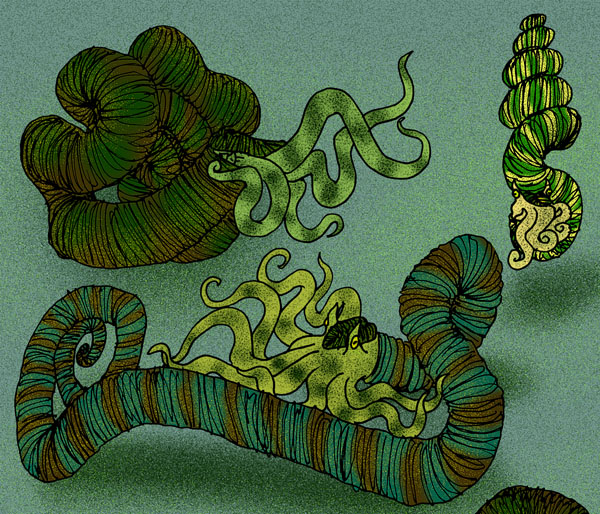




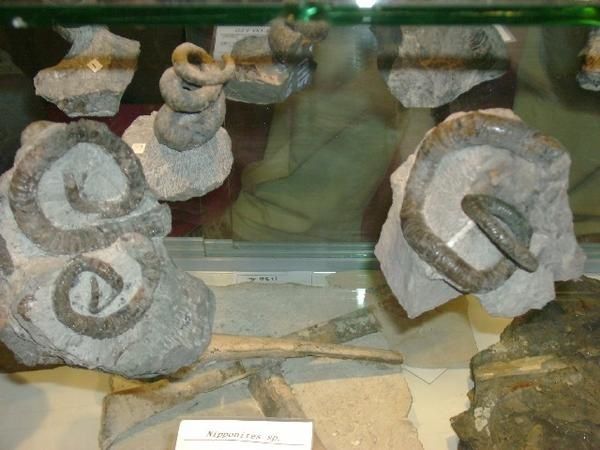







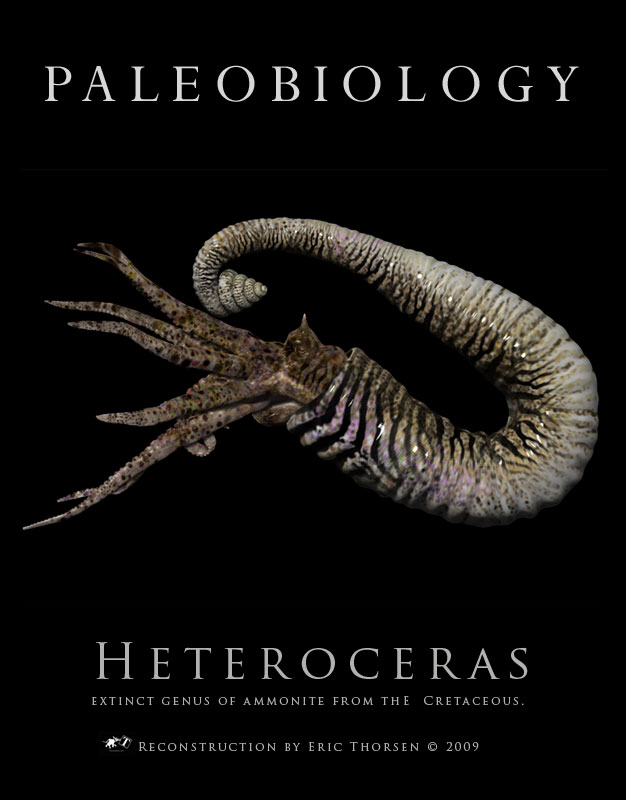












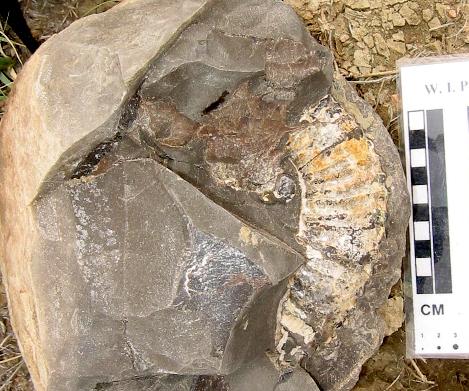







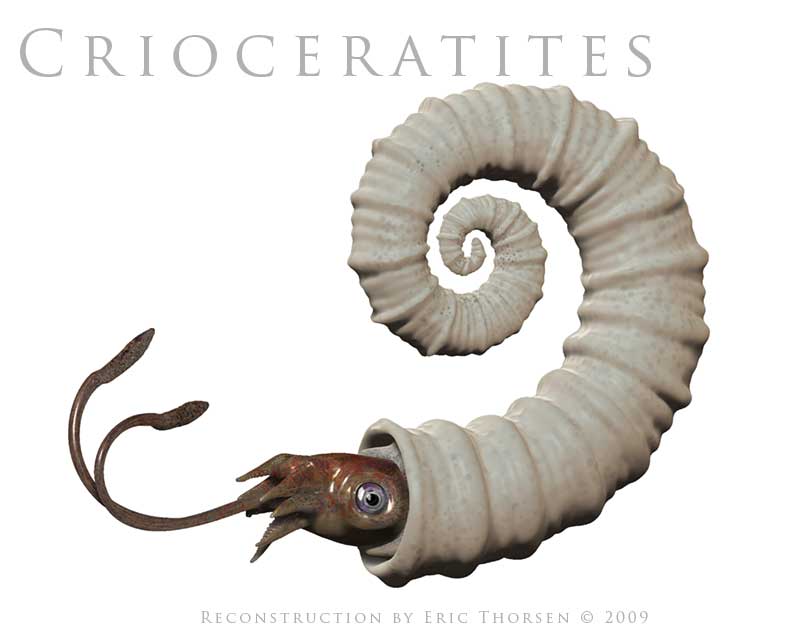






,%20kvas%20na%20papire,%202009%20(gouache%20on%20p.jpg)





